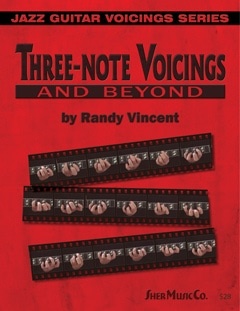
Three-Note Voicings and Beyond
Feb 11, 2015(by Randy Vincent)
With endorsements from various jazz guitar greats such as Pat Metheny, Mike Stern, Jim Hall, Ben Monder, Vic Juris (and many more theThree-Note Voicings book is an obvious must have for serious jazz guitarists ... Randy Vincent synthesizes jazz harmony on the guitar in a clear and concise way. Within its 200 pages, this book can give any player a few lifetimes worth of chordal study and exploration(s) !
 Beginners: don't let that statement intimidate you. It's for everyone, from newcomers up to very advanced players. In fact, this is what I appreciate so much about the book: Vincent managed to start at the foundation of jazz guitar chords and build on that (very solid) framework of basic concepts... up to (very) advanced matters such as upper structure (US) triads.
Beginners: don't let that statement intimidate you. It's for everyone, from newcomers up to very advanced players. In fact, this is what I appreciate so much about the book: Vincent managed to start at the foundation of jazz guitar chords and build on that (very solid) framework of basic concepts... up to (very) advanced matters such as upper structure (US) triads.
Starting from the beginning, with (you guessed it!) three-note voicings you'll learn to hear, see and make sense of the basic "shell" voicings on the guitar (first two chapters). This is good news: finally a focused, well explained and neatly presented way of teaching beginners the nuts and bolts of jazz guitar comping.
Played through common cycles and II-V-I progressions, the 3-note "shell" voicings can develop into your own arsenal of "comping chops" ... for blues, standards and everything in between. In fact, I was about to create a section on JazzGuitarLessons.net explaining *exactly* what is within the first two chapters! I decided not to build those pages since I believe I can't do a better job than Mr. Vincent did. It is well organized and described within a few pages.
Now for the "and beyond" part...
Of course, most intermediate and advanced players won't find anything new in the three-note shell voicings. They might be of use for teaching or review, but that's all. The title has very good reasons of being "Three-Note Voicings AND BEYOND".
Since this is not your typical "chord shapes" book, the author doesn't stop there: ten more chapters await you after the basic 3-note shells!
Some interesting topics are covered then: close and open triads review, "walking guitar" concept, slash chords, upper structures, triad pairs, extensions in dominant cycles, quartal and secundal harmony, drop 2 reductions, Shearing-style voicings, comping ideas, melody harmonization, etc.
Benefits I personally derived from Three-Note Voicings and Beyond:
- Review of basic root-third-seventh "shells";
- Review of triads: close and spread (a new way to "think");
- "Walking" style and passing chords: a more thorough approach (for better comping in guitar-sax duo situations);
- Upper structures applications on altered dominant sevenths chord (using major triads, mostly for my needs);
- Other harmonic subteletties...
In short, Three-note voicings is great for beginners (shell voicings) and for anyone wishing to expand their knowledge of harmony on the guitar. So wherever you stand, I'm sure you'll find some thing(s) of interest to chew on in the book. Start with some free sample pages :
Chapter 1 - Three-Note "Shell" Voicings
Chapter 8 - Quartal Harmony and Secundal Harmony
Then ... Get This Book Now!

Still Hungry? Read this...
(content overview)
Chapters 1 and 2
Three-note voicings "shell". In cycle of fourths, II-V's in two different "locations" on the fretboard, string transference of all voicings (plus all of the above with rootless voicings). You'll get to know the basics for real, a solid foundation in comping that should last a lifetime...
Chapter 3
The four triad types (major, minor, augmented and diminished.) Normal "closed position" and spread triads (plus easy and practical applications on fretboard). For me, this removed some of the confusion in applying triads on the guitar. Neat approach and clear instruction as to "what strings to use and when".
Chapter 4
"Walking Guitar" concept : on II-V-I, cycles, turnarounds, 12-bar blues and Bb Rhythm Changes. Based on triads from previous chapter. Probably the most useful, practical and underated jazz guitar comping technique ever. Make it swing without a bassist now!
Chapter 5
Still using triads from chapter 3, applying to slash chords and upper structure voicings. Any triad can constitute 5-7-9, 7-9-11 or even 9-11-13 of a chord... Lots of food for thoughts. My personal favorites are altered dominant using U.S. bVI and bII.
Chapter 6
Triad Pairs : major with major, minor with minor and some combinations. Once again, mastering triads from chapter 3 is recommend ... I did not actually explore this chapter thoroughly but I see (and hear) the immense potential. I'm used to using triads pair melodically, in improvisation.
Chapter 7
"Fresh looks" into ...
- Dominant 7th chord cycles
- Diminished scales
- Whole tone scales
Very inspiring ideas to spruce up our ordinary three-note voicings.
Chapter 8 - 9 - 10
Some advanced concepts including (but not limited to) ...
- Quartal and Secundal Harmony: The "modern sound" of these open intervals applied to comping situations. Neat examples.
- Drop-2 reductions: Taking basic 4-note drop2's and using only the bottom three notes, top three notes and combinations. Also : *modal* drop2 reductions
- George Shearing-Style Voicings :
Simulated these 5-note chords on the guitar. Applied to bebop scales, extended chords and reductions. - etc.
Chapter 11 - 12
Wrap-up + some neat ideas. Comping concepts on blues and II-V-I's using lots of material from all the previous chapters. Final notes on harmonizing melodies (chord melody style).
Needless to say, Three-Note Voicings will provide any jazz guitarists in need of "chords stuff" with a good fix!
Get This Book Now!
Click to see the full list of my favourite jazz guitar books!









